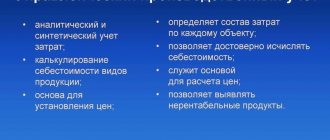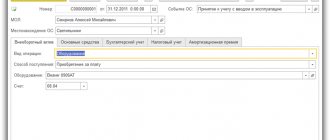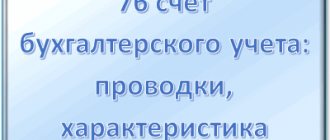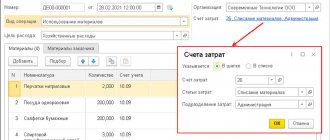Why do we need account 94?
On account 94 “Shortages and losses from damage to valuables,” the accountant collects information about how much the company lost due to losses and shortages of material assets. All shortages that were discovered during inventory in the warehouse or at the cash register, acceptance of goods from suppliers, paperwork, sale of goods, etc. are recorded here.
But there are two exceptions in which the amounts of shortfalls should not be debited to account 94:
- They are within the framework of standards that were agreed upon in advance, provided for in an agreement or law. For example, norms of natural loss or the level of losses that the supplier allows and guarantees compensation if exceeded. Such amounts are immediately written off as expenses.
- They were formed due to natural disasters. Then the amounts are sent to account 99 and form a loss.
It turns out that debit 94 will show the total amount of shortages and losses in the company. To understand how to correctly write off amounts from this account and close it at the end of the period, you must first classify transactions into those that can be covered by the culprits and those that should be written off.
Description of the account “Shortages and losses from damage to valuables”
Account 94 is used to reflect generalized information on the amounts of shortages associated with damage to material and other assets, including money. Turnovers in account 94 are reflected when damage or shortages are detected during the procurement of goods and materials, their storage and sale.
The account is used to reflect the amounts of shortages both when identifying the perpetrators and when writing off losses to the cost of production. According to Dt 94, missing, lost, damaged inventory items (based on actual cost), non-current assets (based on residual value), and partially damaged inventory items (based on the amount of identified losses) are carried out.
Count 94 - active or passive
Account 94 is active. This means that if it is debited in the posting, then the account in which the loss occurred will be credited - this could be account 10 if there is a shortage of materials, account 50 if there is a shortage of money in the cash register, account 76 if there is a shortage goods from the supplier.
If the account is 94 on the loan, the shortage or loss is written off to the source of coverage. For example, if there is a shortage of materials arising during the production of goods, the amount can be written off as cost. If the person who is to blame for its occurrence is known, the amount is covered at his expense and written off to debit 73. If it is impossible to identify the responsible person, the amount goes to account 91 and is added to expenses not related to the main activities of the company.
Examples of accounting entries for account 94
Example 1. Lack of funds
When conducting an inventory at Dandelion LLC, a shortage of RUB 5,000.00 was identified. The shortage of funds was written off to the responsible person A.A. Vasilkova.
The accountant of Dandelion LLC generated the following entries for account 94:
| date | Account Dt | Kt account | Amount, rub. | Wiring Description | A document base |
| 16.12.2016 | 94 | 50.01 | 5 000,00 | There is a shortage in accounting | |
| 20.12.2016 | 73.02 | 94 | 5 000,00 | The shortage is written off to the guilty party | |
Example 2. Shortage within the limits of natural loss and above the norms
When conducting an inventory as of December 1, 2016. LLC "Dandelions" identified a shortage of cherry plum of 5.00 kg for a total amount of 2,500.00 rubles. Of which RUB 2,000.00. written off as natural loss, and RUB 500.00. for excess losses at the expense of the wages of A.A. Vasilkov, responsible for storage.
The accountant of Dandelion LLC generated the following entries for shortages within the limits of natural loss and above the norms:
| date | Account Dt | Kt account | Amount, rub. | Wiring Description |
| 16.12.2016 | 94 | 41 | 2 500,00 | A shortage of goods was identified during inventory |
| 20.12.2016 | 44 | 94 | 2 000,00 | Shortages within the norms are written off as sales expenses. |
| 20.12.2016 | 70 | 94 | 500,00 | Shortages in excess of norms are written off as wages |
Which accounts does account 94 correspond to?
As we have already said, if account 94 is in debit, shortages or losses have been identified. They can be found in almost all areas of an organization. For example, damage or loss of fixed assets may be detected, then they are written off at their residual value (initial - depreciation) to the debit of account 94.
Damaged equipment, materials, finished products, goods for resale can also be written off as shortages, but at actual cost. Losses that arose during the production or sales process are written off to debit 94 from the corresponding cost accounts. In case of loss of cash or monetary documents, the amounts are also debited from 50 to 94 account.
If you sold goods and discovered a shortage, the trade margin from account 42 can be written off to debit 94. If there is a shortage of acquired assets, VAT is written off to the debit of account 94.
The full list of accounts that can be on credit when account 94 is on debit is as follows: 01, 03, 07, 08, 10, 11, 16, 19, 20, 21, 23, 29, 41, 42, 43, 44, 45, 50, 60, 71, 73, 76, 98, 99.
When the credit account is 94, the debit indicates the source of the coverage. The shortfall can be covered at the expense of the person at fault, written off against production costs, increased costs, or simply included in other expenses when there are no other options.
The full list of accounts that can be in debit when account 94 is in credit is as follows: 08, 20, 23, 25, 26, 29, 44, 70, 73, 91.
Features of accounting for shortages and losses from damage to inventory items
Cases of shortage of property and monetary resources of a company are not uncommon and are most often identified during inventory activities. In addition, shortfalls in inventories are possible when supplies are delivered from suppliers, due to natural wastage, as well as due to force majeure.
To reflect aggregate data regarding losses of company property, a special active account 94 is used. On the debit side, the amounts of shortfalls are formed in correspondence with the inventory accounts, and on the credit account 94 is closed in the amount of:
- Shortages/losses according to the amounts stipulated by the contractual terms - when purchasing inventories.
- Shortages/losses within the established norms of natural loss - in the process of storage and/or sale of inventories.
- Shortages/losses in excess of the established norms of natural loss - with identification of those responsible for the theft.
- Shortages/losses in excess of the established norms of natural loss - without identifying the perpetrators of the theft or when it is impossible to prove the fact of guilt.
Postings for identified deficiencies
We will not consider examples of reflecting losses and shortages. We present only standard transactions and their meaning.
| Wiring | The essence of the operation |
| Dt 94 Kt 01 | We reflect the shortage of fixed assets at their residual (initial) value. |
| Dt 94 Kt 07,10,43,41,15 | We write off the shortages from damage to the MC. |
| Dt 94 Kt 16 | Deviations in the cost of missing materials were written off. |
| Dt 94 Kt 42 | The amount of trade margin on missing goods has been written off. |
| Dt 94 Kt 19 | VAT on missing acquired assets has been written off. |
| Dt 94 Kt 50 | Lack of cash or documents at the cash desk. |
| Dt 94 Kt 20,23,44,43,45,90 | Losses incurred during sales or production are written off. |
| Dt 94 Kt 60 | We show the shortage that was noticed during the acceptance of the MC. |
Write-off of shortages as a result of inventory
Regulatory regulation
On the date of completion of the inventory, the organization is obliged to record a shortage of goods in the amount of damage at actual cost:
- Dt Kt 41—shortage of goods is reflected.
In NU, losses from shortages can be taken into account in material expenses for income tax within the limits of natural loss rates (clause 7 of Article 254 of the Tax Code of the Russian Federation). The standards were approved by Decree No. 814 of November 12, 2002 and are applied only if they are established for a specific product in a certain industry.
In accounting, losses within the limits of natural loss norms are written off to the accounts of production costs or sales costs:
- Dt 20 (23, 25, 26, 44) Kt - losses are written off within the limits of natural loss norms.
If there are no standards, the entire shortage is above the standard and must be attributed to the guilty person in full.
Is it necessary to restore VAT when writing off a shortage as a result of an inventory?
This issue has been controversial for a long time. Despite the fact that the write-off of inventory items as a result of a shortage during inventory is not included in the cases in which the Tax Code of the Russian Federation requires the restoration of VAT (clause 3 of Article 170 of the Tax Code of the Russian Federation), tax authorities have repeatedly stated the need to restore the tax (Letter of the Ministry of Finance of the Russian Federation dated May 19. 2010 N 03-07-11/186, dated 01/21/2016 N 03-03-06/1/1997).
However, in 2022, a whole series of letters from controllers was published, in which they take the opposite position. Therefore, today we can say that the opinion of the Federal Tax Service is confidently turning towards taxpayers.
At the same time, in our opinion, it is too early to say unequivocally that there is no tax risk if VAT is not restored. At the same time, if claims are made by the tax authorities, your chances of winning in court are very high.
If you decide to restore VAT, we recommend that you study in more detail the article Restoring VAT when writing off inventory items
How to close account 94 in 1C 8.3
Shortages and losses from damage to valuables are reflected in the account “Shortages and losses from damage to valuables” (chart of accounts 1C). The debit of the account indicates:
- actual cost of completely damaged or missing inventory items.
In the credit of the account, shortages and losses from damage to valuables are written off.
Based on the matching statement, the accountant reflects the shortage, i.e. writes off goods in accounting as of the end date of the inventory.
Based on the document Inventory of goods, create a document Write-off of goods :
- from - date of completion of the inventory;
- Warehouse - a place where goods are stored where a shortage was discovered;
- Inventory - document Inventory of goods , on the basis of which a shortage was identified.
Products tab will be filled in automatically. The data will be transferred from the Goods Inventory the Fill button :
- Nomenclature - Set of curtains "Versailles" , from the Nomenclature , inventory items that are subject to write-off are indicated;
- Quantity - the number of inventory items subject to write-off;
- Accounting account - 41.01 “Goods in warehouses”, is filled in automatically when specifying inventory items based on the register of the Item Accounting Account.
Postings according to the document
Closing 94 accounts in 1C 8.3
The document generates transactions:
- Dt Kt 41.01 - write-off of shortage of goods at actual (book) cost;
- Kt GTD - write-off of goods from batch accounting according to GTD.
Documenting
The organization must approve the forms of primary documents, incl. document on write-off of goods. In 1C, the Act on the write-off of goods in the TORG-16 form is used.
The form can be printed by clicking the Print button - Act on write-off of goods (TORG-16) of the document Write-off of goods . PDF
When to use count 76
In accordance with the chart of accounts (order of the Ministry of Finance of Russia dated October 31, 2000 No. 94n), account 76 “Settlements with various debtors and creditors” is used to collect information related to:
- with insurance;
- claims under contracts;
- salary deposit;
- settlements based on executive documents of employees, etc.
Thus, it takes into account all settlement transactions that cannot be taken into account in other accounts.
This account is active-passive, the balance on it can be either debit or credit. In this case, the debit reflects the debt to the enterprise, and the credit reflects the debts of the enterprise itself.
For more information about accounting for receivables and payables, read the article “How are settlements with debtors and creditors reflected in accounting?” .
Find out what current debt is and how it differs from overdue debt from the Ready-made solution from ConsultantPlus. Trial access to the legal system is free.
When forming the balance, the expanded balance of account 76 is taken into account:
- Dt balances are shown on line 1230 “Accounts receivable”;
- credit balance - according to line 1520 “Accounts payable”.
Depending on the accounting policies applied by the enterprise, it is also possible to assign some groups of receivables (for example, undistributed insurance premiums) to other current assets (line 1260).
Where to write off lost property?
Accordingly, the stage of closing account 94 begins. It occurs depending on the definition of the measure of responsibility.
When they go to costs
If the damage is caused within the limits of natural loss, then it is considered that no one is guilty. In such cases, you need to use expense accounts:
- Dt 44 “Sale expenses” Kt 94 - material costs written off for damage during the sale;
- Dt 20 (23, 25, 26, 29) Kt 94 - damage written off as costs in the process of production activities;
- Dt 96 “Reserves for future expenses” Kt 94 - losses are charged to estimated reserves.
If there is a person responsible
However, if more is damaged or stolen than required by the standard, then the postings for closing the 94th account depend on whether the culprit is found. If a specific person is detected, then the accounting department needs to make entries:
- Dt 73 “Settlements with personnel for other operations” subconto responsible person Kt 94 - the amount of damage is assigned to the culprit;
- Dt 70 “Settlements with personnel for wages” Kt 73 - damage is deducted from the salary of the responsible person;
- Dt 98 “Future income” Kt 91.1 “Other income” - the amount of damage is recovered from the guilty party if the losses relate to previous periods;
- Dt 94 Kt 76 “Settlements with various debtors and creditors” - if a third party is at fault.
Important point! The responsible person must admit his guilt, otherwise nothing can be recovered from him. In such a situation, the company can only go to court and wait for a decision in its favor.
For tax accounting purposes, the amount of the shortfall will be included in non-operating expenses. What the employee paid must be taken into account in non-operating income. The manager may decide to forgive the guilty person. In such cases, the amount of compensation is not included in the tax base.
When no one is to blame
It may happen that the culprits will not be found. This happens when, over the course of a year, worn-out equipment is thrown into a landfill, and no movements occur in accounting. As a result, there is a shortage during inventory. But since management is aware of the situation, there are no guilty parties:
- Dt 91.02 “Other expenses” Kt 94 - the shortage is written off as a loss at the expense of the company.
If the cause of the loss is a natural disaster, then instead of 91, the 99 “Profit and Loss” account is used:
- Dt 99 Kt 94.
In tax accounting, such losses are written off simultaneously as non-operating expenses.
What to do before and during closing
Before the 94 account is closed, the following happens:
- The fact of shortage is established.
- The reasons are determined - natural loss, specified losses, force majeure, or someone’s intent or negligence.
- The amount is attributed to the expenses of the enterprise or to those responsible for the shortage.
Account 94 is closed on credit with the same amounts and quantities that were taken into account as debit. Costs are written off based on the actual cost of the property:
- If the shortage is written off as main production costs, the amount is debited to account 20.
- If intent or negligence of an employee is detected, the write-off occurs to the debit of account 73.
- If the culprit is absent, then the amount of the shortfall is written off to other expenses, debit account 91.
- If losses are a consequence of force majeure circumstances, the write-off is made to the debit of account 99.
An example of closing transactions at the end of the year: in December 2016, an inventory was carried out at MetallurgCom LLC. As a result, a shortage of cast iron worth 10,000 rubles and manufactured spare parts for aircraft engines worth 8,000 rubles was discovered. An operational investigation was carried out and the culprit of the loss was found - supply manager S.S. Smirnov. The amount of losses was deducted from his salary.
Year-end closing entries:
| date | Debit | Credit | Sum. rub. | Wiring Description |
| 18.12.2016 | 94 | 10 | 10000 | A shortage of materials has been identified |
| 18.12.2016 | 94 | 41 | 8000 | Shortage of goods identified |
| 20.12.2016 | 73 | 94 | 18000 | The amount of the shortage was attributed to Smirnov S.S. |
| 20.12.2016 | 70 | 73 | 18000 | From the salary of S.S. Smirnov the amount of the shortfall is withheld |
| 20.12.2016 | 98 | 91 | 18000 | The amount of damages recovered is included in other income |
about the author
Grigory Znayko Journalist, entrepreneur. I run my own business and know first-hand the problems and difficulties that individual entrepreneurs and LLCs face.










